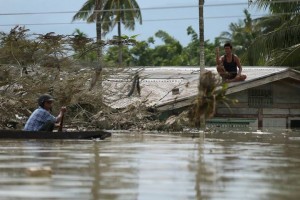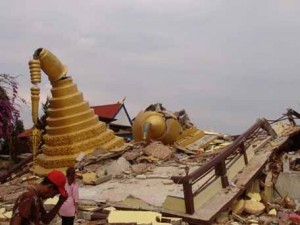Posts Tagged ‘Cyclone Nargis’ (13 found)
Humanitarian Aid not Political Maneuvering
 This year’s monsoon rains have hit Burma harder than most years in the country’s history, leading to the worst natural disaster since Cyclone Nargis in 2008. So far, nearly 100 people have died from the severe flooding caused by heavy rains and flash floods and over one million people have been affected in all but two of Burma’s 14 states and regions since June 2015. Approximately 1.2 million acres of rice fields have been destroyed including large parts of Burma’s “rice bowl,” the Irrawaddy Delta, and nearly 14,000 educational institutions have been temporarily shut down due to this natural disaster […]
This year’s monsoon rains have hit Burma harder than most years in the country’s history, leading to the worst natural disaster since Cyclone Nargis in 2008. So far, nearly 100 people have died from the severe flooding caused by heavy rains and flash floods and over one million people have been affected in all but two of Burma’s 14 states and regions since June 2015. Approximately 1.2 million acres of rice fields have been destroyed including large parts of Burma’s “rice bowl,” the Irrawaddy Delta, and nearly 14,000 educational institutions have been temporarily shut down due to this natural disaster […]
MPs Urge Ban Ki-Moon to Negotiate Humanitarian Access to Rakhine State, Burma
Over 50 MPs in the British Parliament have signed an Early Day Motion (EDM) (a kind of Parliamentary petition) calling on UN Secretary-General Ban Ki-moon to personally lead negotiations for humanitarian access to Rakhine State, Burma. The MPs also call on the British Government to put pressure on the Burmese government to address the root causes of why the Rohingya are fleeing the country […]
• • •Boost for Burma with new UK funding
The UK remains committed to supporting Burma to reach its potential as a peaceful and prosperous country that respects the human rights of its entire people, International Development Minister Desmond Swayne said while announcing new funding at a reception to mark 10 years of DFID’s presence in Burma […]
• • •Shan State Earthquake Victims in Need of Urgent Relief Effort
 On 24 March, a 6.8 magnitude earthquake struck Loimwe, Shan State, causing many deaths and significant destruction to homes and buildings in the area. Affected communities are in great need of humanitarian assistance as they begin to address the damage and rebuild their lives. It is imperative that Burma’s regime and local authorities facilitate the delivery of timely and unimpeded relief in a transparent manner.
On 24 March, a 6.8 magnitude earthquake struck Loimwe, Shan State, causing many deaths and significant destruction to homes and buildings in the area. Affected communities are in great need of humanitarian assistance as they begin to address the damage and rebuild their lives. It is imperative that Burma’s regime and local authorities facilitate the delivery of timely and unimpeded relief in a transparent manner.
As of 27 March, state-run media was reporting the official death toll from the quake as 74. However, eyewitness reports suggested that more than 150 people were killed. Many of the casualties are from Tarlay, where almost every building was damaged and many collapsed. The quake destroyed at least 240 buildings, including houses and monasteries […]
• • •Burma Dashes Asean and UN Hopes of Disaster Cooperation
The Association of Southeast Asian Nations (Asean) and the United Nations are trying to put a brave face on their joint efforts over the past two years to coax the Burmese government into accepting international aid and allowing unfettered access to areas hit by natural disasters.
Many analysts believe, however, that there is no long-term commitment on the part of the Burmese leaders to change their inward looking mentality and obsessive fear of foreigners […]
• •Let’s strongly oppose the 2010 Election which will make the 2008 Constitution come into operation!
All the people of Burma including Monks, Students and Youths,
1. The day of 27th May 2010 will mark 20th anniversary of 1990 Election in which the people representatives overwhelmingly won a landslide victory. The results of that election is interpreted as that of the Burmese people’s ongoing struggle for democracy begin with the 1988 prodemocracy movements, by truly expressing of their determination.[…]
• • •After Cyclone, Repress Impedes Civil Society and Aid
Humanitarian Space Across Country Again Narrowing Ahead of 2010 Polls
The Burmese government continues to deny basic freedoms and place undue restrictions on aid agencies despite significant gains in rehabilitating areas devastated by Cyclone Nargis two years ago, Human Rights Watch said in a new report released today […]
“I Want to Help My Own People”
State Control and Civil Society in Burma after Cyclone Nargis
This 102-page report based on 135 interviews with cyclone survivors, aid workers, and other eyewitnesses, details the Burmese military government’s response to Nargis and its implications for human rights and development in Burma today. The report describes the government’s attempts to block assistance in the desperate three weeks after the cyclone […]
Community-Based Assessment of Human Rights in a Complex Humanitarian Emergency: the Emergency Assistance Teams-Burma and Cyclone Nargis
Cyclone Nargis hit Burma on May 2, 2008, killing over 138,000 and affecting at least 2.4 million people. The Burmese military junta, the State Peace and Development Council (SPDC), initially blocked international aid to storm victims, forcing community-based organizations such as the Emergency Assistance Teams-Burma (EAT) to fill the void, helping with cyclone relief and long-term reconstruction. Recognizing the need for independent monitoring of the human rights situation in cyclone-affected areas, particularly given censorship over storm relief coverage, EAT initiated such documentation efforts […]
• • •ASEAN to Accelerate Aid Delivery to Cylone-Nargis Affected Population
ASEAN will accelerate aid delivery to Myanmar’s Cyclone-Nargis affected population and hand over the coordination structure for post-Nargis recovery efforts to the Government of Myanmar as it prepares to complete its humanitarian operations in the country in July 2010. The decision was made at the 7th Meeting of the ASEAN Humanitarian Task Force (AHTF) held in Ha Noi today. […]
• • •








 All posts
All posts